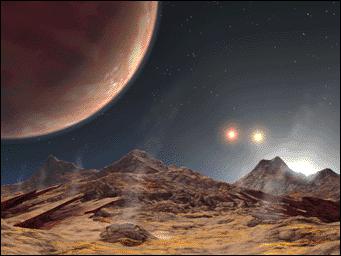Extrasolar planets are by characteristics, very similar to our already well-known planets. The main classification is established according to the type and grade and they are divided into gaseous and solid. Their similarity to the planets of the solar system is a reflection of natural laws that apply to the entire universe. Four fundamental interactions which describes the universe are the strong nuclear force, weak nuclear force, electromagnetic force and gravitational force. All four significantly affect the formation of stellar and planetary systems. Most planets recorded outside our solar system, because of limitations of today's technology, surpassing the size of the created image of an average size of the planet. The planets that are up to ten times more massive than Jupiter and are also gaseous, orbiting a star in periods of only a few months. It could be concluded that in the universe exists mostly just a massive planets, but it is a consequence of our inability to detect Earth-sized planets, because of their proportionately smaller impact on its parent star, which we do not manage to capture.

The smallest planet discovered so far, revolves around the star Gliese 436 and is 33.4 light years away from our system. Its mass of only 5 earth masses indicates that not all the extrasolar planets gas giants. Probably, even greater interest is that its time to cross its orbit is only 5.2 Earth's days, and a period of rotation around its axis is 4 times higher, or 22 Earth days. Because of its rigid nature, the proximity of its orbit to a star and a credible atmosphere that manages to keep the stronger gravitational field, it is calculated that its average temperature is 511 K.
Extrasolar planets (or exoplanets) is a planet orbiting another star, not the Sun, and therefore belongs to another solar system. Exoplanets can be placed in orbit around brown dwarfs as well as around the pulsar.
The first method used to detect extrasolar planets had been watching the anomalies in the regular pulses of pulsars. This led to the discovery of the first planet with orbital period of one year. It was later withdrawn because it was a non-counting motion of the Earth around the Sun.
Astrometry is the oldest method used to search for extrasolar planets, and dates back even from the 1943. It was found several candidates, but none is confirmed, and most astronomers abandoned the method because of the successful ones. However, this method is still useful when it is necessary to confirm the common motion of stars and his own companions. The method involves measuring the normal motion of the stars in search of the impact of causing the planet, but unfortunately, changes in our own movement are so small that currently the best equipment can not provide enough reliable measurement.
Radial velocity method for planet detection is used so that from the spectrum of the stars measure small displacements (circulation) of star. The cause of the circling stars is the mass of a planet orbiting a star, and he was attracted by its gravitational mass, like a dance partners who dance around each other.
Doppler method only works for relatively close stars (up to about 160 light years). It is easy to find planets close to stars, but those that orbit at a bigger distance is difficult to find. The reason lies in the fact that they require a fairly long period of observation, and how this method is young, it is limited with this. Doppler method is useful for confirm findings by using the transit method.
Transit method was recently validated as a method that detects the shadow of the planet as it passes in front of the star around which orbits. The method works only for a small percentage of planets whose orbits are perfectly placed with respect to our viewpoint, but we can detect very distant objects.
